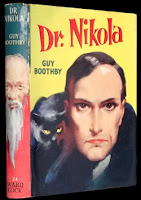April 9, 2012
Frankenstein Out-Frankensteined!
Frankenstein is referenced in this 1935 ad in Film Daily for a proposed Karloff movie to be made in England.
The announced director, Graham Cutts, a co-founder of Gainsborough studios
and once a powerful figure in British films, had seen his career decline
with the advent of talkies. For reasons unknown, the project was shelved and
Karloff was recast in a mad scientist yarn, The Man Who Changed His
Mind, directed by Robert Stevenson and
released in 1936.
Karloff would have made a formidable Nikola, a super-villain
character forgotten today but said to have been as popular as Conan Doyle’s Sherlock Holmes
— and twice as deadly as Professor Moriarty.
Created by Australian-born Guy Boothby (1867-1905), Dr.
Nikola was a charismatic occult villain bent on world domination. His quest for
immortality yielded five best-selling novels between 1895 and 1901, a hit
London play in 1895 and two silent films, in 1909 and 1917. With his weird
laboratory, international connections and nefarious methods, Boothby’s criminal
mastermind is believed to have influenced Sax Rohmer’s Fu Manchu (1913) in many
ways. Even Fu’s pet marmoset is thought to be the equivalent of Nikola’s black
cat companion. Note the ad, artist unidentified, showing a greenish Karloff
with a black cat on his shoulder, a typical Nikola pose found on book covers
and the stage play’s poster.
In a curious connection involving Karloff, it has been
suggested that another Boothby story, A Professor of Egyptology (1904), inspired the screenplay to
Karloff’s The Mummy (1932).
Dr. Nikola was one of
17 films advertised by England’s premiere studio, Gainsborough Pictures, in a
colorful 8-page spread appearing in an October 1935 issue of the New York-based
Film Daily trade paper. Other
titles promoted included the early science-fiction adventure Transatlantic
Tunnel, two Hitchcock films: The
39 Steps and Secret Agent, and two Conrad Veidt vehicles — “Women
fight for Conrad Veidt!” — King
of the Damned and The Passing of
the Third Floor Back. Another Universal
classic, The Invisible Man (1933)
was name-checked — “The Invisible Man makes the future visible” — in an ad for The Clairvoyant, with Claude Rains and Fay Wray.
With thanks to Joe Schwind.
•
01:50
![]()
Labels: Boris Karloff
Subscribe to:
Post Comments (Atom)







2 comments:
If the doctor had been "as popular as Conan Doyle’s Sherlock Holmes," why have I never heard of him? Mind you, I never heard of the Rains and Wray collaboration and I love Claude rains!
Check out CLAIRVOYANT, Keir - there's a good print out there on VHS, and it's a good "Twilight Zone-y" film.
-Craig
Post a Comment